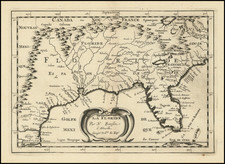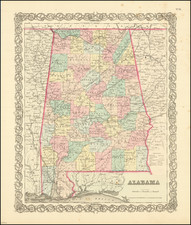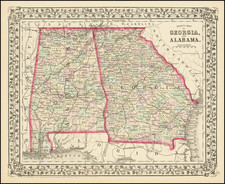An 19th Century Photo of an Early Plan of Mobile, Alabama (Fort Louis de la Louisiane)
Late 19th Century photograph of a manuscript plan of the French settlement of Fort Louis de la Louisiane (Mobile) on the west side of the Mobile River, from an original manuscript plan at the Archives nationales d'outre-mer in Paris.
The map identifies "Terraine de monsieur Iberville," which we believe to be a reference to Jean-Baptiste Le Moyne, Sieur de Bienville, who founded Mobile at its original site in 1702, later moving the town downriver in 1711.
The plan shows an early town grid, street names, buildings, the names of early residents, etc. A fortification appears on the river which may be "Place Royale." The town market is shown at the top left and a seminary at the top right.
Fort Louis de la Louisiane, founded in 1702 by Jean-Baptiste Le Moyne de Bienville, was a French colonial fortification situated at Twenty-Seven Mile Bluff, now part of Mobile County, Alabama. It served as the capital of French Louisiana and was named in honor of King Louis XIV. The fort was a square structure with corner bastions, each armed with six cannons, and included living quarters, a chapel, and a warehouse. Bienville himself resided within the fort, which was fortified with a log palisade. Outside its walls, a village home to roughly 180 men and 27 families was arranged in a grid.
However, persistent flooding plagued the settlement, culminating in a severe flood in the spring of 1711, which inundated the area and forced inhabitants to find refuge in trees for a month. Consequently, a decision was made to relocate the town and fort to a new site downstream, which is now the city of Mobile. By 1712, the move was complete, and the original structures were intentionally burned to prevent their use by potential adversaries.
Mobile History
The French, under Pierre Le Moyne d'Iberville from his base at Fort Maurepas, established a settlement on the Mobile River in 1702. The settlement, then known as Fort Louis de la Louisiane, was first established at Twenty-seven Mile Bluff as the first capital of the French colony of Louisiana.
Mobile was founded under the direction of d'Iberville by his brother, Jean-Baptiste Le Moyne, Sieur de Bienville, to establish control over France's Louisiana claims with Bienville having been made governor of French Louisiana in 1701. Mobile's Roman Catholic parish was established on July 20, 1703, by Jean-Baptiste de la Croix de Chevrières de Saint-Vallier, Bishop of Quebec. The parish was the first established on the Gulf Coast of the United States.
The year 1704 saw the arrival of 23 women, known to history as "casquette girls" to the colony aboard the Pélican, along with yellow fever introduced to the ship in Havana. Though most of the "casquette girls" recovered, a large number of the existing colonists and the neighboring Native Americans died from the illness. This early period also saw the arrival of the first African slaves aboard a French supply ship from Saint-Domingue. The population of the colony fluctuated over the next few years, growing to 279 persons by 1708 yet descending to 178 persons two years later due to disease.
These additional outbreaks of disease and a series of floods caused Bienville to order the town relocated several miles downriver to its present location at the confluence of the Mobile River and Mobile Bay in 1711. This site had previously been settled five years prior by Charles Rochon, Gilbert Dardenne, Pierre LeBoeuf and Claude Parant. A new earth and palisade Fort Louis was constructed at the new site during this time.
The colony was an economic loss, so in 1712, Antoine Crozat took over administration of the colony by royal charter for 15 years, pledging a share of profits to the King. The colony boasted a population of 400 people. In 1713 a new governor was appointed by Crozat, Antoine Laumet de La Mothe, sieur de Cadillac, founder of Detroit. He did not last long, due to allegations of mismanagement and a lack of growth in the colony, and he was recalled to France in 1716.
Bienville again took the helm as governor, serving the office for less than a year until the new governor, Jean-Michel de Lepinay, arrived from France. Lepinay, however, did not last long either, due to Crozat's relinquishing control of the colony in 1717 (after just 5 of the 15 years). The administration shifted to John Law and his Company of the Indies. Bienville found himself once again governor of Louisiana. In 1719, France warred with Spain, and Mobile was on the battlefront, so Bienville decided to move the capital to Old Biloxi, further west.
The capital of Louisiana was moved to Biloxi, (now in Mississippi) in 1720, leaving Mobile relegated to the role of military and trading outpost. In 1723 the construction of a new brick fort with a stone foundation began and it was renamed Fort Condé in honor of Louis Henri, Duc de Bourbon and prince of Condé.
Mobile would maintain the role of major trade center with the Native Americans throughout the French period, leading to the almost universal use of Mobilian Jargon as the simplified trade language with the Native Americans from present-day Florida to Texas.









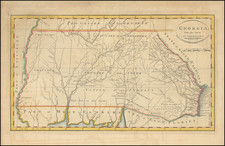
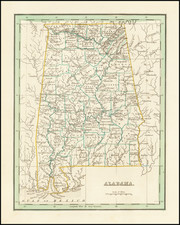
![[ Tennessee / Louisiana / Mississippi / Alabama ] Boston Mountains (408) Radar AAF Aeronautical Chart](https://storage.googleapis.com/raremaps/img/small/97161.jpg)
